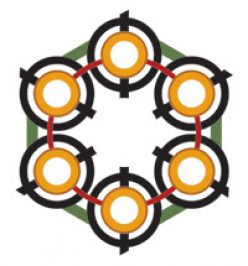Drug checking is a complex and evolving area of research. In EcstasyData’s effort to show accurate findings to the public, we’re working with the unique conditions of each sample. Most recently, the lab has innovated in its handling of LSD gel tabs.
There’s LSD, and then there’s gel tab LSD
Since 2014, the year EcstasyData’s lab developed its procedure for a practical and time-efficient way to identify LSD using GC/MS, gel tabs have been infrequently submitted for analysis. The majority of LSD samples submitted to our lab use blotter paper as the carrier (the lab requires that all samples be dry, no liquid samples are accepted without prior arrangement), though it is Erowid Center’s opinion that most of the LSD currently in distribution is in liquid/solution form.
Prior to 2017, the rare gel tab sample would get refused by the lab’s main chemist, who at the time did not feel confident that these samples could be adequately analyzed for the presence of LSD.
Besides analyzing each sample using GC/MS, which is the analytical method EcstasyData uses to detect the presence of chemicals, the lab also tests samples with reagents. Reagent testing adds descriptive data that adds to the collective knowledge base for drug checking. (Reagent testing can’t positively identify chemicals.)
It turns out that gelatin as a medium makes reagent testing more complicated; the pH conditions required to dissolve the gel affect the reagent even when dried. For this reason, gel tabs do not react normally to field reagents such as Marquis or Ehrlich.
De-weirding reagent colors
Between 2017 and November 2018, five gel tab samples were analyzed by EcstasyData, with GC/MS showing that four of them were LSD. The Ehrlich reagent reactions for these four samples were atypical. LSD normally reacts to Ehrlich reagent by turning purple, but when Ehrlich was applied directly to the dry (or even wet) gelatin in these cases, the results were mixed, turning brown or brown-purple, or other atypical reactions.
The lab began working with the special needs of these samples, and in November 2018, they developed a sample-preparation procedure that allows Ehrlich reagent to show a typical positive (rule-in) response to LSD in gel tabs.
New process for gelatin
We are publishing Erowid Center / DDL’s new procedure that is being used to process dry-gelatin-tab dose units, for the historical record, and so that others can duplicate it and critique it.
The following is the procedure that was used to produce the photo shown for Sample 6813, the first sample treated in this way:
- Gel medium placed in small amount of water.
- Basify gel-water mixture with NaOH.
- Gel medium fully dissolves.
- Solvent (ethyl acetate) added to gel-water mixture.
- Solvent separated off and dropped onto ceramic well plate.
- Unheated evaporation of solvent until dry.
- Drop field reagents into wells, photograph.
This is the process that the lab will use to prep future gel tab samples for reagents. It will be interesting to see how other samples respond to it, and whether further tinkering with the process will be required.
